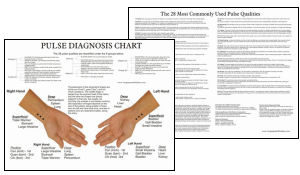Acupuncture and TCM Books
The Secret of Chinese Pulse Diagnosis
 The Secret of Chinese Pulse Diagnosis
The Secret of Chinese Pulse Diagnosis
by Bob Flaws
View price and availability from Amazon
DESCRIPTION: Chinese doctors have used pulse diagnosis as one of their four main methods of diagnosis for at least 2,000 years. Even to this day, this art is integral to the correct identification of traditional Chinese medical patterns of disharmony. Although most practitioners of acupuncture and Oriental medicine give lip service to the importance of the pulse in their practice, few practitioners in the West feel really competent in this art.
In this book, Bob Flaws, one of the most famous Western practitioners of Traditional Chinese Medicine in the world, shares his secret for learning how to do Chinese pulse diagnosis. Bob has identified a single key secret technique which will unlock Chinese pulse diagnosis for all who apply it. Using this technique, anyone can feel the 27 or 28 classical pulses in their clinical practice.
INTRODUCTION
This book is a basic introduction to pulse examination as it is used in Traditional Chinese Medicine or TCM. Although in Chinese, TCM is simply referred to as zhong yi or Chinese medicine, I do regard what is usually called TCM in the West as a particular style of Chinese medicine. Many of the adherents of this style would simply say that TCM encompasses all that has been found to be worthwhile and clinically valid over the 2000 years of recorded Chinese medical history and that is why it is simply called Chinese medicine. Be that as it may, here in the West, there are a number of styles of Oriental medicine currently being taught and practiced. Therefore, I think it useful to distinguish this style for what it is. Hence, before attempting to understand the role and practice of pulse examination within this style, I believe it is important to understand something about this style in general.
TCM as a Style
The hallmark of TCM as a style of Chinese medicine is its emphasis on treatment based on pattern discrimination (bian zheng lun zhi). This means that, although TCM practitioners first make a disease diagnosis (bian bing), treatment is based more on the pattern discrimination than on that disease diagnosis. In other words, the overall guiding treatment principles for the case at hand are based on the pattern discrimination, not on the disease diagnosis. It is these principles which guide the selection of the Chinese medicinal formula or main acupuncture points. Once these main principles are stated and a basic treatment protocol is erected based on these principles, medicinals or acupuncture points are then added to the base protocol depending on their empirical efficacy for the particular disease under treatment.
TABLE OF CONTENTS
1 Introduction
2 The Divisions of the Pulse at the Inch Opening & Their Correspondences
3 Feeling the Pulse Images
4 The Technique of Examining the Pulse
5 Interpreting the Pulse
6 The Indications of the Main Pulse Images
7 Pattern Discrimination & The Pulse Images
8 Pulse Images & the Three Positions
9 The Pulse in Gynecology
10 Traditional Pulse Lore Contained in Mnemonic Verse
11 The Rhymed Formula of the Heart Methods of the Pulse
12 Unusual Pulse Images
13 Reading the Cubit Positions
14 Yin Fire & the Pulse
BIBLIOGRAPHY
GENERAL INDEX

The Secret of Chinese Pulse Diagnosis
by Bob Flaws
View price and availability from Amazon
Pulse Diagnosis Chart
This 8.5" X 11" double sided laminated chart shows the patients hands from the doctors perspective, making learning pulse diagnosis much easier. The chart contains list the pulse location on both right and left hand with Chinese name.
Placement of the doctors fingers for reading the pulse.
A brief description of the pulse charateristics on the front with a detailed description of the 28 pulse characteristics on the back of the chart.
Influences that affect the pulse such as seasonal changes.
